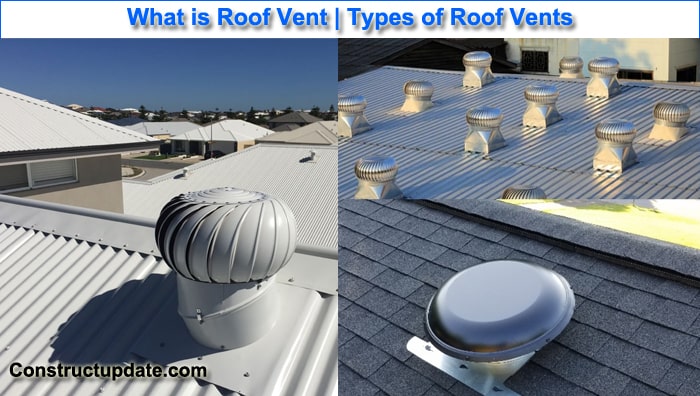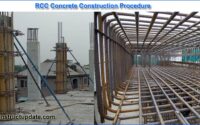What are Roof Vent | Roof Vents Types | Roof Vent Methods
What Is a Roof Vent?
Roof ventilation is a mechanism that allows air to circulate via the vent. Roof vents are a must in every home. However, many homeowners are unfamiliar with their roof ventilation systems. Roof vents aren’t something you have to think about, but they should.
Roof vents, also known as attic vents, ensure a sufficient amount of circulation and ventilation in your attic. Roof vents are designed to keep you cool in the summer and dry in the winter.
By providing a mechanism for burning moist or stuffy air to leave your home, realistic airflow and circulation make it more livable. Both hot and cold seasons necessitate attic ventilation.

The method behind roof ventilation
Under the roof and under the eaves, there should be sufficient air space for insulation and air flow. Furthermore, a well-built system would precisely balance intake and exhaust ventilation under the roof so that the attic is slightly pressured, preventing conditioned air from being sucked out too quickly through the vents, raising heating and cooling costs.
Ventilation only works when air flows. There are two primary methods to create airflow within an attic:
Mechanical: Requires a power source.
Natural: Natural roof ventilation is utilised whenever practical. The stack and wind effects work together to circulate air organically.
When heated air rises, it creates a higher pressure at high locations in the attic, which is known as the stack effect. Exhaust is the hot air that departs. However, without an intake for cooler, low-pressure air, this heated air cannot escape. The intake of cool air is referred to as intake. The wind effect occurs when wind blows against the outside of a roof, increasing the volume of intake and exhaust. The natural flow of air is created by intake and exhaust, resulting in a well-ventilated attic.
Benefits of roof ventilation
When it’s hot outdoors, ventilation is also beneficial to a roof. The temperature on your roof can nearly treble when the temperature outside climbs. A heated roof over a poorly ventilated attic equals a scorching attic.
The heat that builds up in unventilated or inadequately ventilated attics has nowhere to go. This heat buildup might cause your shingles to deteriorate from the inside out. The hot air will leave through a properly vented roof, keeping your roof and attic cooler.
We all want to stay cool inside while the weather outside rises. Heat can escape through a properly vented roof, lessening the burden on your air conditioner. This one is straightforward: a less-running air conditioner means a cheaper electric cost.
Poorly ventilated roofs are frequently the cause of indoor temperature extremes. Your home will be more pleasant all year if your roof is properly vented to allow hot air to depart and cool air to enter the attic space.
A properly planned and installed attic ventilation system, together with adequate attic insulation, will provide excellent temperature and moisture control, protecting your house from unnecessary damage and assisting in the maintenance of acceptable indoor temperatures all year.
A roof ventilation system helps remove overheated air and moisture from the attic and roof system, as well as lessen the impact of changing temperatures and moisture levels both inside and outside the property, by delivering a continuous flow of air through the attic space.
Intake and exhaust vents are installed at strategic intervals in the attic or roof area to allow for air circulation. Various types of vents may be utilised in various locations to allow attic air to circulate in the proper volumes and directions throughout the roofing system.
Types of Roof Vents
1. Exhaust Vents
Exhaust vents allow exhaust to escape; examples of common types are listed below.
(a) Wind Turbines / Whirlybird Ventilation
Whirlybirds are also the name given to wind turbines. These are one of the several aged roof vent kinds available. You could remember the wind turbine from your childhood home or from an older residence.
Perhaps you already have one in your house. The roof vent of a wind turbine does not conduct energy. As the name suggests, that process is all about air flow. The ability of wind to disperse and release air is a puppy.
2. Power Vents
Roof vents of this type are powered by electricity. Electric-powered attic vents are another name for them. These motorised vents can be installed on your gable or roof. You can pick from a variety of hues to find one that matches your other colours. Furthermore, the majority of the roof power vents are low-profile. They’re spherical and little, and they’re near to your roof. Hardwired and solar-powered powered vents are the two most common varieties.
(a) Hardwired Power Roof Vents
A hardwired power roof vent is the most popular type of power roof vent. This is what you’ll be utilising if you don’t want to use a solar-powered roof vent. This sort of roof vent is directly hooked into your home and is usually controlled by a thermostat or humidistat. They might, however, be controlled by a manual switch instead. The connected roof vent can be installed to a gable or a hole cut into your roof. Your hardwired vent should be paired with an intake vent, such as a soffit vent, just like other vent types.
(b) Solar-Powered Roof Vents
Because they are driven by solar energy, solar-powered roof vents differ from hardwired roof vents. The solar panel attached to the mount powers these roof vents, which are eventually fueled by the sun’s rays charging the panel. If your roof receives a lot of natural light, these are great. This is probably not the best answer for you if your roof is shaded during the day. The fan is powered by the solar panel, which propels large amounts of air out to assist cool the attic or roof space. Hardwired models often move more air than this.
(c) Off- ridge vents
Off-ridge vents are an uncommon type of vent. They are not as well-known as other types of vents, and finding information on them might be difficult. They work similarly to box vents, which we’ll talk about next. Roof cutouts are required for off-ridge vents.
(d) Box Vents
Another well-known and popular vent alternative is box vents. You’ve probably seen that small box perched on a rooftop. You might even come to a rooftop with several people sitting on it. When it comes down to it, ridge vents or box vents are the most usually recommended vents.
(e) Ridge Vents
Ridge vents are the latest and greatest in ventilation technology. These appear to be quickly becoming one of the most popular venting alternatives. Your roofing company may insist on this type of vent system if you are having a new roof.
(f) Cupola Vents
The cupola vent is also a terrific way to add a little something extra to your roof. These vents are both enormous and attractive. Sheds, barns, and outbuildings are more likely to have a cupola vent than most houses. It is, nonetheless, a useful vent that is still in use today.
(g) Hip Vents
The hip vent is similar to the ridge vent in appearance. For a hip roof, the thought process behind a hip vent is as follows. This sort of roof is usually in the shape of a pyramid. The roofs are steep and strongly sloping, with no ridges on which to employ a ridge vent.
3. Intake Vents
Intake vents are usually used in conjunction with another type of ventilation. This draws in air and circulates it through another system, thereby cooling the area.
(a) Soffit Vents
Soffit vents are a type of vent that has its own look. These vents are usually put into the underside of an eave rather than immediately on the roof. They could potentially be at their peak.
(b) Drip-Edge Vents
The drip-edge vent is designed to function similarly to the soffit vent. Not every home is built with enough space under the eaves for a soffit vent. Drip-edge vents are useful in this situation.
(c) Over Fascia Vents
The fascia vent is an excellent choice for hip roofs. Why? Because the hip roof has a pyramid shape. There isn’t much of an edge, and there aren’t any eaves to attach drip-edge or soffit venting.
Advantages of Roof Ventilation
- Roof ventilation is essential for every homeowner since it provides a variety of benefits. Roof vents work throughout the year and in all weather conditions to keep your home as safe as possible.
- Appropriate attic ventilation will help your roof last longer by keeping the shingles cooler. Roof vents will provide air circulation during the warmer months to allow hot air to escape. As a result, the attic and roof will be significantly cooler. When the roof unwinds more benevolently because to poor ventilation, this heats the roof shingles. The shingles become harmed as a result of this.
- As a result of the ventilation, homeowners will be able to reduce their energy costs. When we display the more warm months and summer demands, we expect our homes to remain chilly. A well-ventilated roof will allow hot air to escape quickly. The attic cools as the hot air escapes, reducing the demand on air conditioning systems.
- Roof vents also aid in the reduction of high indoor temperatures. We’ve all gone upstairs and discovered it to be far more kind than downstairs. If this prevails, it may be due to an insufficiently vented roof. If hot air cannot escape, it will condense in your home’s top terraces.




